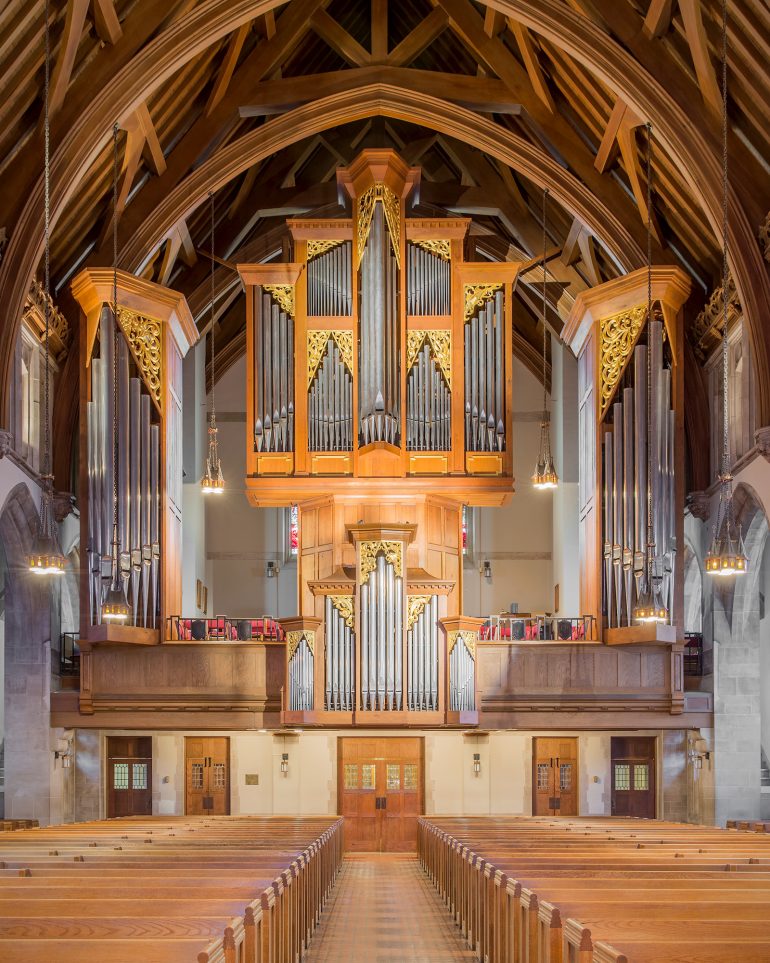
- phone: 978.283.1909
- email: cbfisk@cbfisk.com
Opus 78
House of Hope Presbyterian Church
Saint Paul, MN
Ranks: 97Independent Voices: 63
Pipes: 4568
Created: 1979
The largest organ built by the company during Charles Fisk’s lifetime, at the time Opus 78 was also the largest tracker organ built in this country in the twentieth century. An intentionally eclectic instrument, it incorporated ideas from the study of historic European organs and more recent lessons from the building of earlier Fisk organs. It was Charles Fisk’s talent to find a way for pipe scales from the Silbermann brothers to coexist with those based on the 17th century Stellwagen Brustwerk at the Jakobikirche in Lübeck. He included Gambas and Flûtes Harmoniques in the style of Cavaillé-Coll to make possible a true 19th century French Romantic sound, while in the Great, German reeds with leathered lead-faced shallots developed circa 1580 by the Scherers, stand side by side with 8′ and 4′ French reeds representing the 18th century influence of Dom Bedos de Celles. Much of the pipe work is hammered lead and some, including the façade, is 70% tin.
Reversible composition pedals included for ease of changing stops affect the Great Flue Chorus, the Great Reed Chorus, and the Swell Forte stops. Other registration pedals include ventils to the Great windchest, the Pedal flues, and the Pedal Reeds similar to those found on French Romantic instruments. In 1992 a Kowalyshyn Servopneumatic lever was added to make key touch more sensitive when playing with the manuals coupled.
The oak casework includes gilded hand-carved pipe shades, most with a sea motif. Those in the Positive case were designed and executed by Morgan Faulds Pike of Gloucester, and those in the main case and the Pedal towers by Roger Martin of Rockport, Massachusetts.
Great, man I
Prestant 16′
Octave 8′
Gambe 8′
Flûte harmonique 8′
Bourdon 8′
Octave 4′
Rohrflöte 4′
┌Superoctave 2′
└Grave Mixture II
Cornet V
Mixture VIII-XII
Double Trumpet 16′
German Trumpet 8′
French Trumpet 8′
Orlos I-III (4′)
Rückpositiv, man II
Holzquintadehn 16′
Prestant 8′
Bourdon 8′
Octave 4′
Baarpijp 4′
Grosse Tierce 3 1/5′
┌Nazard 2 2/3′
└Sesquialtera II
┌Doublet 2′
└Night Horn 2′
Sharp V-VIII
Dulcian 16′
Trechterregal 8′
Cromorne 8′
Swell, man III
Stillgedackt 16′
Diapason 8′
Chimney Flute 8′
Viola da Gamba 8′
Voix Céleste
Italian Principal 4′
┌Quinta 2 2/3′
└Sesquialter II
┌Fifteenth 2′
└Fourniture IV-VI
Contra Hautboy 16′
Trumpet 8′
Oboe 8′
Clarion 4′
Brustwerk, man IV
Gedackt 8′
Quintadena 4′
Waldflöte 2′
┌Tierce 1 3/5′
└Echo Cornet III
Quinta 1 1/3′
Cymbal III
Regal 8′
Schalmey 4′
Pedal
ContraBourdon 32′
Prestant 16′
Subbass 16′
Octave 8′
Gedackt 8′
Superoctave 4′
Mixture V
ContraBassoon 32′
Trombone 16′
Cornopean 8′
Shawm 4′
Couplers:
Rückpositiv to Great
Swell to Great
Brustwerk to Great
Swell to Rückpositiv
Octaves graves (1992)
Great to Pedal
Rückpositiv to Pedal
Swell to Pedal
Brustwerk to Pedal
Accessories:
Kowalyshyn Servo-pneumatic
Lever (1992)
General Wind Stabilizer
General Tremulant
Tremblant Doux
Key Compass: Manuals 56 notes CC – g3, Pedal 30 notes, CC – f1
Composition Pedals: On and Off Pedals to Great Flue Chorus
On and Off Pedals to Great Reed Chorus
On and Off Pedals to Swell Forte Stops
Ventils: to Great, to Pedal Bourdons (32′ & 16′), to Pedal Reeds
Servo-pneumatic Machine applied to the Great manual and all coupled divisions.
Key action: Direct mechanical, except for certain bass pipes.
Stop action: Direct mechanical.
